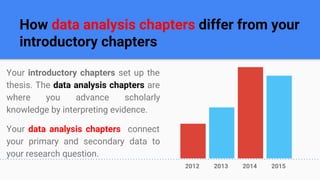
Unraveling Insights: Mastering Dissertation Data Analysis
Welcome to the world of dissertations and capstones, where a significant part of the research process revolves around analyzing mountains of data. Dissertation data analysis plays a pivotal role in uncovering valuable insights and drawing meaningful conclusions from the vast quantities of information collected. Whether you’re conducting a study in the social sciences, natural sciences, or any other discipline, the ability to master data analysis is paramount to producing a robust and credible research output.
Embarking on this journey can be both exciting and daunting at the same time. As you delve into the realm of dissertation data analysis, you will soon realize the multitude of options available to you. From quantitative methods, such as statistical analysis, to qualitative approaches, such as thematic analysis, the choices can be overwhelming. The challenge lies in selecting the most appropriate techniques that align with your research objectives and enable you to gain a deeper understanding of your data.
In this article, we will guide you through the process of mastering dissertation data analysis. We will explore various data analysis methods and equip you with the knowledge and tools necessary to navigate this intricate terrain. Whether you are just beginning your dissertation journey or are already knee-deep in data, this comprehensive guide aims to unravel the complexities of data analysis, empowering you to analyze your findings with confidence. So, let’s embark on this data-driven adventure and unlock the captivating insights hidden within your dissertation research!
Understanding the Importance of Data Analysis
Data analysis plays a crucial role in dissertations and capstones as it allows researchers to make sense of the vast amount of information they have collected. By carefully examining and interpreting the data, valuable insights and conclusions can be drawn, contributing to the overall significance of the study.
First and foremost, data analysis enables researchers to uncover patterns, trends, and relationships within their data. This process involves organizing, categorizing, and summarizing the collected information, allowing for a deeper understanding of the research topic. Through effective data analysis, researchers can identify key variables and factors that influence the phenomenon under investigation.
Moreover, data analysis helps to validate or refute research hypotheses. By subjecting the data to various statistical tests and measures, researchers can assess the significance of their findings and determine whether they support or contradict the initial hypotheses. This ensures that the conclusions drawn from the data are grounded in empirical evidence and have a solid basis.
Additionally, data analysis allows researchers to generalize their findings to a larger population or make predictions about future occurrences. By applying appropriate statistical techniques, it is possible to extrapolate the results obtained from the sample to a broader target population. This provides a basis for making informed decisions and recommendations based on the research findings.
In summary, data analysis is a fundamental component of dissertations and capstones. It unlocks the potential of the collected data, allowing researchers to derive meaningful insights and draw valid conclusions. By understanding the importance of data analysis, researchers can effectively utilize this process to enhance the quality and significance of their research.
Approaches to Dissertation Data Analysis
When it comes to conducting data analysis for dissertations and capstones, there are several approaches that researchers can utilize. These approaches play a significant role in unraveling valuable insights from the collected data. In this section, we will explore three popular approaches to dissertation data analysis.

Qualitative Data Analysis: One approach to dissertation data analysis is qualitative analysis, which involves the examination of non-numerical data such as interviews, surveys, and textual materials. Researchers employing this approach immerse themselves in the data, seeking patterns, themes, and relationships to gain a deeper understanding of the research question. By employing various methods such as thematic analysis or content analysis, qualitative data analysis helps in interpreting subjective information and providing rich, context-specific insights.
Quantitative Data Analysis: Another commonly used approach is quantitative data analysis. This method involves the use of statistical techniques to analyze numerical data and test hypotheses. Researchers employing this approach typically collect data through surveys, experiments, or other structured methods. By applying statistical methods such as regression analysis or t-tests, quantitative data analysis provides researchers with numerical evidence to support or reject their research hypotheses, allowing for objective conclusions to be drawn.
Mixed-Methods Data Analysis: A third approach that is gaining popularity is mixed-methods data analysis. This approach involves combining both qualitative and quantitative data analysis techniques. By integrating different research methods, researchers can benefit from the strengths of each approach and obtain a more comprehensive understanding of their research topic. Mixed-methods data analysis allows for triangulation, where researchers can validate findings by corroborating qualitative insights with statistical evidence or vice versa, enhancing the overall rigor of the study.
Dissertation Proposal Writing Service
In conclusion, approaches to dissertation data analysis vary depending on the nature of the research question and the type of data collected. Whether utilizing qualitative analysis, quantitative analysis, or a mixed-methods approach, researchers can employ these techniques to unravel meaningful insights from their data, making their dissertations and capstones more robust and impactful.
Tips for Effective Dissertation Data Analysis
When it comes to conducting effective dissertation data analysis, there are a few key tips that can help researchers make the most out of their findings.
Organize your data: Before diving into the analysis, it is crucial to ensure that your data is well-organized. Create a systematic structure for storing and categorizing your data, whether it be in spreadsheets, databases, or specialized software. By keeping your data organized, you can easily locate and access the information you need for analysis.
Choose the right analysis methods: Depending on the nature of your research questions and the type of data you have collected, it is important to select the appropriate analysis methods. Consider whether your data requires qualitative or quantitative analysis, and choose techniques such as statistical analysis, thematic coding, or regression analysis accordingly. Utilizing the most suitable methods will enable you to extract meaningful insights from your data.
Interpret and validate your findings: Once you have completed your analysis, it is crucial to interpret and validate your findings. Avoid jumping to conclusions without thoroughly examining the data. Look for patterns, trends, and correlations that could provide deeper meaning to your research. Additionally, consider seeking validation from peers or experts in your field. This can help ensure the accuracy and reliability of your analysis results.
By following these tips, researchers can effectively unravel insights from their dissertation data analysis, leading to a comprehensive and impactful dissertation or capstone project.



